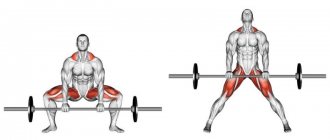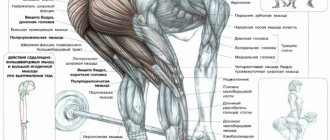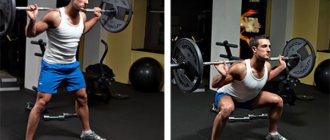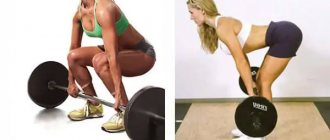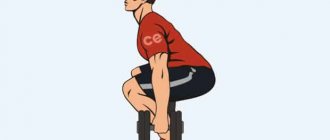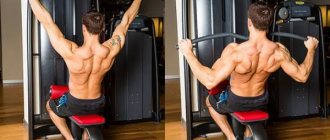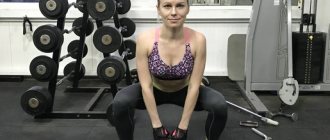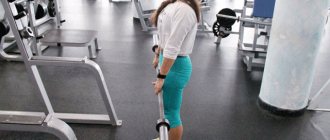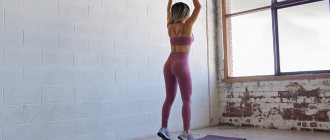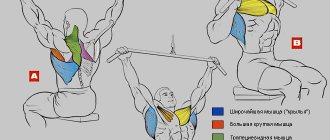Engaging your legs is vital as this is where the largest muscles in the body are located. As you progress toward your fitness goals, you'll burn more calories (both during and after your workout). Today we're going to talk about the sumo deadlift and how it can help you!
You may have heard something about the sumo deadlift, but what exactly is so great about it?
After all, when it comes to being in good physical shape, the image of a huge sumo wrestler is the last thing that comes to mind.
The movement itself has little in common with sumo wrestling per se, but it does work the lower body very well. In this article we will give all the answers about the sumo deadlift. Here we'll answer all your questions about the sumo deadlift, including whether or not you should include it in your training program at all.
- Sumo or classic deadlift, which is better?
- What is a sumo deadlift?
- Proper Deadlift Technique
- Purpose of sumo deadlift
- What muscles work in the sumo deadlift?
- Who should do sumo deadlifts?
- Example workout
- Conclusion
Sumo or classic deadlift, which is better?
For beginners, it is better to use the classic version of the exercise due to the more natural position of the joints when performing. It is also well suited for short or overweight athletes.
Sumo-style deadlifts are better for tall athletes because they allow you to shorten the movement and thereby lift more weight.
Another feature is that in the classics the gluteal muscles are used more and the inner thighs are less, while in sumo, on the contrary, the buttocks work less and the inner thighs work more. If this is important to both of you, then draw appropriate conclusions.
But for general training and working out the muscles of the body, it is better to use different options at different stages of preparation.
I'm sure you've heard a lot of different names like Romanian deadlifts, sumo deadlifts, and sometimes people even ask what the difference is between a squat and a deadlift.
Over time, you will likely become comfortable with your current training program.
You know what to expect from lifting weights, how to perform them correctly, and how much you can do on each exercise.
However, constant changes in the training process, increasing or decreasing weight in the training program are important for many reasons.
- First, you keep shocking your muscles. Muscle stress is very important for developing both strength and size. Over time, your muscles become accustomed to performing certain movements. Once this happens, the impact on the muscles is greatly reduced. You no longer feel sore the morning after your workout, and the gains in strength and size fade away. Adding some movements and abandoning others forces the body to constantly expect a trick. And that means tone, which is essential in the world of weight training and strength building.
- Secondly, new movements always work the body a little differently.
Even if you replace one row with another, the movement will be slightly different, which will cause the muscle fibers to move slightly differently. Even these small changes force the muscles to rebuild and adapt to new types of loads, which leads to constant growth and improvement in strength, which you will not achieve by simply repeating the same movements every time you come to the gym.
It's for these reasons that we recommend looking into new deadlifting techniques that you haven't previously incorporated into your workouts, including the sumo deadlift.
Important tips for performing the exercise
When mastering the sumo-style deadlift technique, you need to take into account several significant points:
- When starting to work in this version, you should not immediately move on to heavy weights, even if you have experience performing deadlifts in the classical way. The priority should be practicing the correct technique.
- To make it more convenient to hold the bar, many athletes use an overhand grip (a position in which the palms are turned in different directions). But this is only justified in competitions, when the weight usually only needs to be lifted once, and not in training. This position of the hands leads to an uneven load on the spinal column and increases the risk of injury. It would be preferable to take the projectile with your palms facing you and, if necessary, using the straps.
Using straps when performing the exercise
- This technique requires a rather narrow grip, which makes it difficult to control its position. To prevent the plates from sliding off the bar during training, they need to be secured with locks.
- When lifting, you need to keep your abdominal muscles tense: this will ensure that you maintain an optimal body position.
- To control the correct execution of movements, it is advisable to position yourself in front of a mirror.
All aspects of the sumo style deadlift can only be fully learned through practice. By experimenting with the width of the legs and grip, the weight of the projectile and the number of repetitions, you will soon be able to choose an option that will make the training effective. The main thing is to achieve the correct technique and not force the load to avoid injury.
What is a sumo deadlift?
The last word in the title should give you some thoughts about what you have to do.
In the classic deadlift, which you already do as part of your program, you have a barbell with plates in front of you.
You lower yourself almost into a squat, with your feet approximately shoulder-width apart, grab the barbell in front of you and keep your back straight. You then explosively yank the barbell upward, holding the barbell with your hands as your lower body pushes you upward. This important exercise works almost the entire lower half of the torso, in addition to this, the lower back is involved and, depending on how you hold your shoulders, the trapezius can also be captured.
The sumo deadlift is similar to the regular deadlift in many ways.
The only difference, at a minimum, is that the technique of performing a sumo deadlift involves a special positioning of the legs.
This is where the name traction comes from. Imagine a sumo wrestler getting ready to throw. Most likely it will be an image of a very large Japanese man in a vanishingly small amount of clothing, with his legs spread very wide, as if he specifically wanted to show how little he was wearing. It is the width of the stance that forms the basis of the sumo deadlift. The spread of the feet is what changes. You need to place your feet much further than shoulder-width apart and turn your hips outward.
From this position, the movement is performed in the same way as any other deadlift.
What muscles work
In the photo, the bodybuilder’s body relief is impressive! Traction promotes maximum load on the muscle groups of the legs and back. The muscles involved are:
- Gluteal.
- Large round dorsal.
- Lat.
- Trapezoidal.
- Diamond-shaped.
- Spinal extensors.
- Posterior thigh.
During training, the hands and forearms receive additional stress, because they have to hold the barbell suspended. The rectus and oblique abdominal muscles help stabilize the core.
The maximum load is received by the extensor muscles of the spine, namely the lumbar region. Less load is placed on the latissimus dorsi muscles. The hamstrings, glutes and quadriceps begin to work actively. With the classical technique, the gluteal muscles and the back of the thigh receive significantly less load, and therefore are more suitable for the stronger half of humanity.
When performing sumo deadlifts, the load on the muscles of the buttocks and hamstrings significantly increases. Sumo is characterized by increased stress on the inner thighs. During the exercise, the semitransverse and semitendinosus muscles are also involved in the work, together with the deep muscles of the back of the thigh.
Proper Deadlift Technique
Sumo-style deadlifts are probably not something you do often in the gym. Although, of course, there are gyms where you rarely see anyone doing a deadlift at all.
However, if you are already more or less accustomed to traditional deadlifts, performing this variation will not be difficult for you.
By changing the position of your legs, you shift the emphasis in the muscles involved (more on this later). In order to complete it, you will have to pay close attention to the scales. When you do this deadlift variation for the first time, it's best to unload the bar slightly to get a feel for how your body reacts.
Stand in front of a barbell with a weight loaded on it. Place your feet significantly wider than your shoulders. You will most likely feel some tension on the inside of your thighs. If you have not previously stretched and warmed up this part of the body, now is the time to do so. You can even do a few unweighted squats in this position before you start, just to activate the right muscles.
Grasp the barbell, keeping your back flat and straight.
In order to grab the barbell, you will have to bend at the waist. The grip will be the same as with a regular deadlift, that is, approximately shoulder-width apart. However, depending on your preferences, various small variations are acceptable. We accept an overhand, underhand, and different grip. Experiment freely to see what works best for you.
Lower yourself, bending your body slightly.
Due to the wide stance of the legs, the thighs will be almost parallel to the floor. Make sure you are looking forward, chest out, and back completely straight. The main weight will fall on the back of the legs. Expand with an explosive movement, pushing off with your legs. You hold onto the bar and your lower body does all the pushing up.
When the bar passes the line of your knees, push your pelvis forward, at this time bringing your shoulder blades together. This adds elasticity to the shoulder girdle. To increase the load and further work your shoulders, hold your shoulder blades together for a while before returning to the starting position. Make sure you have the correct body position as the barbell lowers down, then repeat. Compliance with all the nuances is very important.
Types of deadlifts and their features
Proper execution of a deadlift requires a certain degree of mobility in the hips and chest, as well as flexibility in most of the “posterior chain” (calves, hamstrings, glutes, back).
Deadlift with dumbbells or kettlebell
I understand that many people are a little intimidated by a heavily loaded bar, so you may want to start with a lighter weight. For most beginners, I recommend starting with light weight equipment such as dumbbells or kettlebells, although any other object can work. Some people who practice at home use jugs filled with sand!
Personally, I find that kettlebells work great in this situation because the weight is distributed evenly. When starting the exercise, make sure the kettlebell is directly underneath you, in line between the bases of your feet. For those who have limited mobility, a wider foot position, the so-called “sumo” position, which I will discuss below, may be better suited.
Deadlift with trap bar
For those who are stronger or have access to a trap bar, I recommend starting with this variation of the exercise. This bar is specifically designed to allow you to stand at your center of gravity, making it mechanically easier to lift the weight. Most trap bars come with special handles for lifting the barbell. This is a huge benefit for those with limited mobility. Plus, you won't have to bend over as much to lift the barbell. This bar makes it much easier to maintain a neutral spine position throughout the entire exercise.
Just remember that this exercise is hip and back dominant, and don't forget about proper hip movement. Don't turn your deadlifts into squats, and remember to push your hips back as far as possible and your glutes forward as you lift the weight.
Sumo style deadlift
The sumo deadlift, or wide-legged deadlift, is suitable for people with limited mobility or beginners who have weak backs, as this position allows you to grip the bar without stressing the lower back as much as a traditional deadlift does. The disadvantage of this option is that when lifting heavy weights, more stress is placed on the hip joint, which may not be suitable for people suffering from pain or dysfunction in the sacroiliac joint.
The distance between the legs in the sumo deadlift ranges from slightly wider than hip-width (half sumo) to a very wide stance where the toes almost touch the weight plates. Most people choose a position somewhere between these two points
It is very important that the socks are turned to the sides. Depending on the person’s physique, the rotation angle can be from 45° to 90°
The bar should be grasped shoulder-width apart. This grip is different from the traditional deadlift grip, where the hands are wider than hip-width apart.
As with any deadlift, make sure you push your hips back first. The peculiarity of the sumo deadlift is that in it the hips are much lower and the chest is higher than in other versions of the exercise. To begin lifting the weight, push your feet off the floor as if you want to spread it out to the sides, and also remember to tighten your butt muscles.
Classic deadlift
For most people, I recommend learning the traditional deadlift last because it requires good joint mobility and a strong back to perform it effectively.
The starting position of your feet should be somewhere between hip and shoulder width, with your toes pointing forward or slightly turned outward. Don't forget to keep your shins close to the bar!
Grab the bar with your hands wider than hip-width apart. Keeping your spine in a neutral position, push your hips back AND down so that the angle of your hips is close to that of a sumo deadlift.
Since this exercise places a special load on the back, as well as the whole body, it is necessary to strictly follow the correct technique to make the exercise safe.
The deadlift is one of the best ways to increase overall strength, strengthen your core, and improve your posture, as long as you use proper form and a deadlift variation that's right for you. Do some deadlifts and be sure to leave a comment below!
Based on materials:
www.builtlean.com/2013/03/27/proper-deadlift-form/
Purpose of sumo deadlift
You're essentially doing the same movement as a traditional deadlift.
So why might you need to change anything?
It's all about foot placement and how it results in shortening the distance the weight is lifted. By rotating your hips outward, you put more stress on your hamstrings. A narrower stance distributes the weight throughout your hips, glutes, calves, and even quads. In this case, it falls almost entirely on the hamstrings. This makes the sumo deadlift one of the best exercises for this area imaginable (especially when combined with the sumo squat).
You also engage your hamstrings in a completely different way than most lower body exercises. Since you are standing in the same stance as a hamstring exercise, this is obviously how you are engaging the muscles. The sumo deadlift works the biceps and inner thighs. Thus, it allows you to load not only the area immediately under the buttocks, but also along the entire length of the legs.
By strengthening your inner thigh muscles, you will improve your technical performance in all exercises that involve your lower body.
Romanian deadlift
To take the starting position, you need to get as close to the barbell as possible so that it hangs over your shin (practically touching your legs). Place your feet shoulder-width apart or slightly wider, your feet should be parallel to each other (no need to turn your toes to the sides).
Grasp the bar with a regular grip (the back of your hand is facing away from you, and your palms should be turned towards your body). The distance between the hands should be slightly greater than the width of the shoulders. The elbows should be slightly bent, the back straight, as if a bar is fixed along the spine, the shoulder blades should be brought together, and throughout the entire lift (from the bottom to the top point of the exercise), the position of the back and shoulder blades should be unchanged.
When lifting the barbell, your back should remain flat without rounding or arching. When lifting the barbell, you need to straighten your back to a vertical position - this is the starting position.
Having risen to the top point, you need to move your pelvis forward so that your back is strictly vertical. This is done every time you lift, while the whole body should remain tense and the shoulder blades retracted. Next, leaving the position of the shoulder blades unchanged, we bend our back and at the same time bend over and at the same time move the pelvis back (the tilt and abduction must be performed synchronously, and in no case sequentially). When bending, your back should remain arched. At the lowest point, you should not round your back, and the strongest muscle stretch should be felt in the back of your thighs.
You need to lift the barbell using your hamstrings. The maximum lifting height of the projectile is slightly above the knees (or mid-thigh). When lifting, the bar should move vertically along the shins (very close to the legs), and the body should move back, while it should bend at the knees and hip joints. The foot joints should not bend and the knees should not move forward
It is important to move smoothly at the very beginning of the climb without jerking. The secret of the correct technique for performing this exercise lies precisely in the lifting; it should be done with the effort of the legs, not the back
The feet should seem to be rooted to the floor, and as you rise, you need to push the floor back. In this case, the back does not get tired.
Lowering the bar is performed using the same technique. The arms do not straighten, the knees are slightly bent and remain that way during the bending process (there is no need to bend them anymore). That's really all the deadlift is. What muscles work when performing one of the options? This is the question that interests novice bodybuilders. And the answer to it is simple, these are the hips, buttocks and back, only in each option the emphasis shifts a little.
What muscles work in the sumo deadlift?
The traditional deadlift is a classic and one of the best, if not the best, deadlift exercises out there. This is because it works almost every muscle group in the back of the body. Therefore, it should also not be sent to the bench in favor of another exercise. However, you can (and I think you should) add sumo deadlifts to your rowing exercises. Just like a regular one, it uses a large number of muscles in the back of the body.
The target muscle groups in this case are the hamstrings and gluteal muscles. You work this area (especially the tendons) more than with a regular deadlift due to the wide stance.
The abductor muscles are also well worked out. It also works the quadriceps, although this greatly depends on how wide you can spread your legs. And when deadlifting, your forearms also strain, but this is quite obvious, because although the legs do the main work, you still hold the weight with your hands.
As for the secondary muscles, almost the entire back is involved. Thanks to the retraction of the shoulder blades, which you perform at the top of the row, your trapezius receives its portion of the load. Additional stabilizing muscles for this particular deadlift include the hip flexors, abs, and rhomboids.
Basic leg exercises
Let's first talk about basic leg exercises. After all, many ignore this muscle group, but in vain.
Squats
Barbell squats are one of the fundamental exercises in many sports. In this movement, almost all muscle groups of your body work in one way or another. The main dynamic load falls on the quadriceps, hamstrings, spinal extensors, gluteal muscles and hip adductors. When working with serious weight, a significant static load falls on the abdominal muscles, shoulders and trapezius muscles.
Vitaly Sova — stock.adobe.com
A clear position of the head helps stabilize the movement - the gaze should be directed strictly in front of you or slightly upward, this will make it psychologically easier for you to get up from a lower position.
Don't forget about the position of your feet - in general, they should be placed slightly wider than your shoulders, with your toes pointing to the sides. When rising from a squat, never bring your knees together.
This also includes squats in Smith and hack machine. These movements are a little simpler in terms of technique. The general principle is the same, but the position of the body and the projectile is more fixed, which is why fewer stabilizer muscles are involved in the work.
mountaira - stock.adobe.com
Leg press
The platform leg press cannot fully replace heavy squats with a barbell, but the load on the legs is no less: the front, back and inner thighs and gluteal muscles work. Perfect for beginners for whom the squat technique will be too difficult at the initial stage.
The most important thing in this exercise is not to overdo it with the working weight. This will make it more difficult for you to control the correct position of your knees. If you bring them inside the trajectory of movement, you risk injury to the ligaments.
It is also important to work in a comfortable amplitude. Do not try to lower the platform as low as possible. The geometry of most exercise machines is designed in such a way that at the lowest point your spine will be rounded in the coccyx area
This is an extremely traumatic position. At the top point, you don’t need to straighten your knees all the way, leave them slightly bent
The geometry of most exercise machines is designed in such a way that at the lowest point your spine will be rounded in the tailbone area. This is an extremely traumatic position. At the top point, you don’t need to straighten your knees all the way, leave them slightly bent.
Lunges
You can perform lunges with your own weight, with a barbell or dumbbells. In any variation, you will use all areas of the leg muscles. Depending on the width of the step, the direction of movement and the position of the foot, you can slightly emphasize the load on one or another area: with a shorter step, the emphasis falls on the quadriceps, with a wide one, on the hamstrings.
If you perform a step in such a way that at the bottom point the angle between the shin and the thigh of both legs is 90 degrees, the load is equally distributed on the front and back surfaces of the thigh.
Sumo deadlift
This is a variation of the classic deadlift, in which the emphasis shifts to the legs (adductors, quadriceps and hamstrings) and works the back to a lesser extent. This is achieved through wider stance of the legs. The range of motion in a sumo stance is a little shorter, but this does not eliminate the powerful static tension in the abdominal muscles, back, trapezius and arms.
The correct technique for performing a sumo deadlift involves a deep squat in the starting position and maintaining a straight back throughout the entire exercise. This way you minimize the risk of back injury or umbilical hernia.
Athletes who are not involved in powerlifting should avoid using an underhand grip, as it can also lead to spinal injury. Use a regular overhand grip; you can attach straps if the weight is too heavy.
Romanian deadlift
It is often mistakenly called a deadlift, although in fact a deadlift is a regular classic deadlift. In the Romanian version, the legs remain slightly bent throughout the entire approach; the work is mainly carried out by the extensors of the spine and biceps of the thigh. That is why this exercise can be considered a basic one for the back. It’s also a good idea to include the gluteal and other additional stabilizers (trapezius, calf, etc.).
There is no need to perform this movement with fully straightened legs, as this can cause injury. The angle of the knees should not change throughout the entire approach. The bend should be done to a comfortable point, stretching is different for everyone, it should not be done through pain
It is also important not to hunch your back; if you can’t do this, reduce the working weight
Another version of this exercise is with dumbbells, the technique here is identical, but the emphasis shifts more to the gluteal muscles.
Who should do sumo deadlifts?
This is truly a great deadlift variation that everyone should at least try.
Of course, if you spend time in the gym practicing all the deadlift techniques, you can stay there. Sumo deadlifts can be added to a routine along with regular deadlifts, or done periodically in place of them, changing them every few weeks to continue to surprise the muscles in your lower body (and to keep your workouts from getting boring with monotony).
As for who should do sumo deadlifts instead of regular ones, it all comes down to the traumatic nature of the exercise. The sumo deadlift places much less strain on the lower back and spine.
So if you suffer from back pain or have had an injury to the area, switching to sumo deadlifts will give you the ability to perform the exercise without putting your back at risk.
Tips and tricks
A few words about the mistakes common to beginners, as well as about the nuances that will help in performing the exercise.
We recommend reading about how to do Romanian barbell deadlifts.
Common mistakes
A few words about the most common mistakes:
- To perform deadlifts, you need the right shoes. It should have a thin sole and provide rigid traction to the surface. Even the minimal reduction in amplitude that a thin sole provides can bring some bonuses. Wrestling shoes are an excellent solution, but barbells are more suitable for other barbell exercises.
- Large distance from the projectile to the feet. This circumstance makes it difficult to control and coordinate the body. Due to the large length of the lever, the barbell will outweigh you.
- Weightlifter's belt and straps. It is better to avoid using these pieces of equipment. They can indeed provide an advantage of several kilograms, but this advantage will be obtained at the expense of technique.
- Do not try to spread your legs too far, this can lead to spraining. Position your feet so that you can stand on them confidently and perform the exercise.
- The back should never be rounded. The back should always be straight, with a slight arch in the lower back.
Nuances and tricks for implementation
There are ways to increase the efficiency of this traction:
- Do not try to sit down deeply before performing the exercise; it will make it more difficult for you to perform deadlifts. In addition, in such a situation the quadriceps are more involved, and you are now working on other groups.
- Constantly monitor your movements. To do this, it is better for a beginner to practice in front of a mirror. Take a break between repetitions so that your technique does not suffer from the pace you take. Remember: technique is more important than weight and reps.
- Most back exercises work the legs, and vice versa. Therefore, space out the training of these groups in order to avoid excessive stress. For example: train your back on Tuesday and train your legs on Saturday.
- If you're just starting to introduce sumo deadlifts into your training program, try starting with 90% of your maximum lifting weight. It will be enough to perform 4-6 repetitions of the exercise.
The sumo deadlift is a great exercise for training your lower torso muscles. Working almost the same areas as the classic version of the exercise, only with a slightly different emphasis, it can become both your main type of deadlift and a complement to the classics.
This exercise can also be a solution to the problem for those who do not do the classics due to pain in the lower spine.
Example workout
As with most powerlifting movements, it all depends on whether you want to work for strength or size.
If this is your first time doing the exercise, be sure to start with a light weight.
Even if you're a seasoned lifter, shifting your focus takes time for your muscles to adapt, so you likely won't be able to lift heavy weights right away.
If your goal is strength, do 3 sets of 4 reps . There are likely many more pulling exercises in your later program, so once you complete this deadlift, stop and move on to the next one. However, if time is pressing or you end the program with sumo deadlifts, add an additional fourth set, but use a lighter weight for it and do 12 reps.
This can help burn off any remaining energy and push your lower body muscles to the point of failure.
If you just want to build muscle and not increase strength, do eight to 12 repetitions.
If you can do 12 reps without difficulty, you need to increase the weight. 9 or 10 reps is your benchmark. Do three sets and increase the weight each time if you did 12 reps before. You need to bring the body to a state of muscle failure. If you've done 12 and can still lift weights, then you're not getting the full benefit out of the exercise.
Muscle work
As already mentioned, sumo technique is designed to lift maximum weight
And to achieve this goal, it is important, firstly, to force the largest number of muscles to work in concert, and secondly, to reduce the amplitude of movement of a heavy projectile (for this purpose, wide stance of the legs is used)
The exercise affects many muscles of the body, including the largest groups. The main work is performed by:
- Legs and buttocks: quadriceps, hip adductors, hamstrings, gluteus maximus. The load on the legs and buttocks in the sumo deadlift is higher than in the classic deadlift.
- Back: spinal extensors, latissimus dorsi, trapezius. Sumo-style deadlifts load your back less than classic ones.
- The forearms are stressed by holding a barbell in your hands.
Advantages and Disadvantages of Sumo Squats
Like all exercises, sumo squats have both positive and negative sides. Check them out and decide whether you should do it. Or maybe not.
Advantages
- Sumo squats help develop the gluteal region. This is especially important for girls. Those who want to have a round butt, but at the same time do not affect the growth of their hips.
- The ability to perform squats for tall athletes.
- Due to the smaller range of motion, you can take a much larger weight of weight. Of course, all this is done gradually to minimize the risk of injury.
- Sumo squats can be performed with a variety of weights. Starting from dumbbells and ending with barbells. Therefore, it can be performed both at home and in the gym.
- This is a strength exercise, so during sumo squats the body experiences extreme stress. What gives impetus to the growth of muscle mass.
- The flexibility of the knee and hip joints also improves.
- When performing sumo squats with weights, the muscles of the back and abdominal cavity are strengthened. This reduces the risk of spinal injury.
- Well, the most important thing is that the entire lower part of our body develops. This will help increase strength in other basic exercises that are performed while standing. For example: ARM BENDING WITH A BAR or OVERHEAD BAR RAISES.
Flaws
- Mastering the sumo technique will take much longer than classic squats. This is especially true for beginner athletes. Therefore, achieving results with sumo squats is a more labor-intensive activity.
- There is a high risk of injuring your lower back. This is mainly a consequence of incorrect technique.
- The load on the quadriceps will be much less than in classic squats. This fact must also be taken into account for men who will take sumo squats as their main ones. But this disadvantage can be easily compensated for by the large weight of the burden. Of course, within reasonable limits.
As you can see, there are also disadvantages. And some of them can turn out to be very serious if they are not taken into account. But if you make every effort and wait a little. Then all these shortcomings will not affect you. And you will only get positive results from sumo squats.
Female version
We are talking about sumo squats with an emphasis on the gluteal muscles. Of course, men can also perform them if this area is lagging behind in their development. A variety of equipment is used as weights: dumbbells, weights or barbells. For beginner athletes, it is best to start getting acquainted with the exercise without weight. Then take a light dumbbell or bodybar for 4-6 kg. When working with a barbell, do not forget about safety measures. We perform squats in a power rack with installed limiters. On which we can place the barbell if we cannot stand with the barbell. We take the barbell from the racks, not from the floor. We are in no hurry to increase working weight.
Initial position:
- If you plan to perform sumo squats with a barbell. Then set the bar to the desired height (just below your shoulders).
- Be sure to use restraints, even if you are confident that you can handle the given weight.
- Climb under the barbell and place the bar on your back, near your rear delts.
- We grab the bar with our hands with a wide grip.
- As you exhale, remove the barbell from the racks by straightening your legs.
- Let's take one step back.
- We spread our legs wider than shoulders. We turn our socks 45°. They should face the same direction as your knees.
- Keep your back straight, shoulder blades pulled together.
- The gaze is directed upward and forward.
- To squat with a dumbbell and kettlebell, just take them in two hands and lower them down.
Performance:
- After you have decided on the weight and taken the starting position. We take a breath and begin to bend our legs at the knee joints. At the same time, we move the pelvis as far back as possible. And we lean forward a little. This will give us the opportunity to stretch the gluteal muscles.
- We try to squat as deep as possible, using the full potential of the gluteal muscles.
- We begin returning to the starting position from the pelvis. That is, we move it forward, at the same time we straighten our legs. It is important that all the emphasis goes to the heels; this will prevent us from pushing our knees forward beyond our toes. Therefore, the quadriceps will not take the entire load on itself.
- In the starting position, you should not completely straighten your legs. To avoid overloading the knee joints.
Control your every movement, avoiding inertia and jerking. Start squatting only after you are sure that the barbell is securely resting on your shoulders.
Male version
For men, the implementation will be slightly different. Since their buttocks are not a priority muscle group. Basically, everyone strives to develop the front of the thighs. We are talking about the quadriceps femoris muscle, or as many are accustomed to calling it the quadriceps. In order to shift the emphasis to this group, it is necessary to exclude pelvic abduction and forward tilt of the torso. This will prevent the gluteal muscles from working alone. To do this, we will have to sacrifice the amplitude of movement and perform a half squat. That is, we bend our legs until the pelvis is parallel to the floor. At the same time, we try to keep the torso in an upright position, avoiding bending forward.
Initial position:
The starting position will be no different from the previous version.
- That is, we also set the bar to the desired height.
- We crawl under the bar. We stand up with him by straightening our legs.
- We take a step back and spread our legs wide. The back is straight, the gaze is directed forward and upward.
- When working with other weights with dumbbells or kettlebells. We hold the projectile with both hands, lowered down.
Performance:
- While inhaling, we begin to bend our legs at the knee joint.
- As soon as we bend our legs at 90° degrees, exhale and return to the starting position. It is imperative that all the emphasis goes on the heels.
- Repeat the specified number of times.
As you can see, this option is no different from classic squats. Except for the width of the legs and range of motion. But for tall athletes, this is the only opportunity to perform this exercise.
Features of the exercise
Speaking about what sumo squats are, it is worth remembering its history. We associate the word “sumo” with overweight people of Asian descent and their struggle. It is from them that the exercise gets its name, since when performing it we take a pose similar to the pose of a sumo wrestler in the arena.
Sumo wrestlers seem very clumsy, but in fact their physical shape is very good. They devote several hours a day to training, including stretching and strength training. Sumo wrestlers also do similar squats while holding a large stone at chest level. Due to the fact that sumo wrestlers constantly stretch their muscles and ligaments, they can squat very low. In any case, a good stretch will benefit no one, especially women.
Sumo squats help work the muscles in your lower body , targeting areas that traditional squats don't work. They have the following advantages:
- They provide a comprehensive study of the muscles, in particular, the traditional female problem area - the inner thighs.
- Develop flexibility of the hip joints and improve mobility.
- Improves blood circulation in the lower body. This helps improve the condition of the skin and has a beneficial effect on the pelvic organs.
- The exercises are not demanding on space and equipment. They can also be performed at home.
Sumo squats are more difficult than classic squats. In order to squat wide and not bring your knees inward, you need sufficient physical preparation. The exercise loads the knee joints. You need to take less weight for it than for classic squats. And to practice the technique, it’s better to do without weights altogether or use an empty bar.
Errors
- While moving, your knees should not go past your toes. They should also not fall inside or wander from side to side.
- During sumo deadlifts, your back should not round. Otherwise, it is easy to “earn” a back injury.
- If you are doing the exercise for the first time, practice with an empty bar. At the initial stage, it is important to hone your technique.
- All movements must be smooth, jerking is not allowed. If you cannot maintain the correct technique, it is better to reduce the working weight.
- If you have trouble holding the bar in your hands, try changing your grip. On a straight line, reverse, or better yet, a different grip.
- Throughout the entire trajectory of movement, the barbell should be literally a couple of centimeters from the shins or thighs.
basic exercisesdeadliftsumo deadlift
